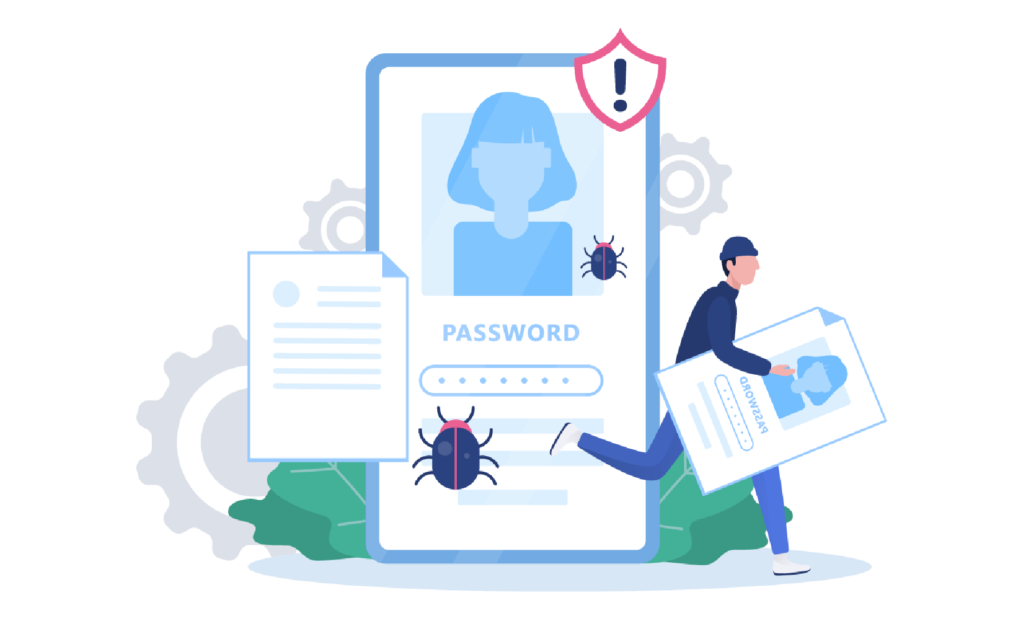Why Your Business Isn’t Prepared for Digital Identity Theft
According to a 2021 study, financial fraud, including identity theft, costs the world around $5.38 trillion per year—equivalent to a staggering 6.4% of total global GDP!
What’s more, this figure is growing every year, as cybercriminals become increasingly sophisticated in their social strategies and arsenal of malware tools. As a result, digital identity theft is one of the biggest perils facing businesses. If left unchecked, it can lead to massive financial losses, legal consequences, and destroyed relationships with customers or business partners.
If you’re not sure whether your business is prepared to face this threat, it probably means you have room for improvement. But don’t worry—the best time to learn about cybersecurity is now, and this article covers just about everything you should know about the risks of digital identity theft and how you can prevent it from becoming a problem.
What Are the Risks of Identity Theft for Businesses?
There are so many types of identity theft that it can be hard to keep track of the red flags and best practices in order to avoid falling victim to them. To simplify things, we’ve compiled a list of the main types of identity theft that could threaten your business’s bottom line:
- Credit Identity Theft: This involves criminals stealing personal information like Social Security Numbers (SSN) and using it to open fraudulent credit accounts or obtain loans in the victim’s name. It could harm your business account’s credit rating if not quickly noticed.
- Tax Identity Theft: Similarly, criminals can make fraudulent tax benefit claims or file false business tax returns. If this goes unreported, your business could face legal consequences such as fines or audits.
- Employee Identity Theft: Sometimes, rogue employees may misuse the personal information of your customers or other employees. Your business could face a public relations nightmare, and, if found to have acted negligently, be sanctioned in court.
- Account Takeover: Even scarier, some sophisticated criminals may gain access to your bank accounts, gaining the ability to siphon huge sums of money. Besides the obvious financial risk, the paperwork involved with disputing these transactions will take days or weeks to work through.
- Business Relations Impersonation: If malicious actors gain access to enough information, they could impersonate your business’s identity and attempt to defraud your partners. Even if the other party catches on to what’s happening, it’d still severely undermine trust in your security processes.
- Vendor/Supplier Impersonation: Likewise, your business could be targeted by impostor criminals pretending to be legitimate vendors or suppliers. Their modus operandi is to send fake invoice details and hope you send the money, as it’s hard or impossible for you to receive a refund.
Suffering from an identity theft attack has myriad consequences for your business. Not only could your finances be hit hard, but it’ll mean a lot of time, effort, and paperwork to redress the situation. That’s not to mention how it could harm relations with your customers or partners, who may no longer trust that your internal security measures are up to scratch (even if it was just a one-off!)
The best course of action, then, is to take a preventative approach toward digital identity theft. Preparing yourself to notice the early warning signs and having a plan of action is better than getting caught off-guard and rushing to clean up the damage.
What Are the First Signs of Identity Theft?
Watch out for these common red flags associated with identity fraud so you know when to take quick action:
- Unexplained charges, withdrawals, or transfers on your business’s bank account
- Sudden unauthorized account access
- Suspicious login attempts or password reset requests
- Credit denials or drops in your credit score without a clear reason
- Unexpected notices from tax authorities
- Complaints from customers, suppliers, vendors, or employees
- Cybersecurity incidents, such as data breaches or malware injection.
What to Do if You Discover Identity Fraud
Learning that you’ve fallen victim to identity theft will of course be unsettling, but taking prompt action is crucial to minimize damage. Follow these steps to get to the bottom of what has happened:
Stay Calm and Gather Information
Take a deep breath and stay composed. Begin by collecting all relevant information related to your case, whether it’s an unexplained bank statement, invoice, or letter from the tax authorities. Use call tracking for small business to record information about incoming calls from suspicious numbers.
Contact Your Financial Institution
If you notice discrepancies in your business’s bank account, reach out to your financial institution immediately. Inform them of any unauthorized transactions and ask for assistance securing your account—they will know what actions to take.
Freeze Your Credit
Reach out to the three major credit bureaus (Experian, TransUnion, and Equifax) and ask to freeze your credit, preventing anyone from opening a new line of credit in your business’s name. This is a free service and you can lift the suspension upon request.
Secure Your Online Accounts
If you’ve experienced suspicious login attempts or password reset requests, change your account passwords immediately. Follow password best practices, like using unique passwords for each account and using two-factor authentication for finances.
Report the Identity Theft
Contact your local police department or digital law enforcement agency and report the fraudulent activities along with all of your documentation. If you receive unexpected notices from local tax authorities, you should also contact them promptly.
Conduct a Cybersecurity Assessment
In case of cybersecurity incidents like data breaches or malware attacks, conduct a thorough assessment of your business’s cybersecurity measures. Identify how the cyberattack happened and close off any vulnerabilities that led to it.
Prevent Future Incidents
Whatever happened, it’s important to look at it with fresh eyes and learn from it, especially if the theft could have been easily prevented. Once the immediate issue is resolved, you can turn to focus on preventing future identity theft incidents. We’ll explore top tips for this in the next section.
How to Protect Your Business from Digital Identity Theft
Employee Education and Training
The first line of defense in your strategy against digital identity theft is your employees.
It doesn’t matter how strong your cybersecurity framework is, if it can be entirely circumvented if an unwitting insider accidentally sends funds to the wrong place, or provides access to a sensitive account or file.
Implementing comprehensive training for new and existing employees to ensure they know the role they play in cybersecurity is, therefore, paramount.
Most of this stuff is really simple—knowing how to identify phishing emails, not plugging in random USB sticks, locking your PC when not at your desk—but that doesn’t mean it’s not your responsibility to teach it. Hopefully, doing this will massively reduce the odds of a breach occurring; but if it does, then at least your organization won’t be held accountable due to negligence.
Robust Cybersecurity Measures
As cybercriminal strategies grow more sophisticated, it’s more important than ever for businesses to securely fence off their data storage and networks. Start by investing in strong cybersecurity infrastructure, including firewalls, antivirus software, and intrusion detection systems.
Keep all software up-to-date with the latest security patches, and use NIST cybersecurity framework controls to identify, protect, detect, respond, and recover sensitive files.
Image sourced from nist.gov
Multi-Factor Authentication (MFA)
Multi-factor authentication makes it much harder for hackers to access restricted files or accounts.
It works by requiring additional forms of verification, such as a phone, email, or MFA app code, to prove to your system that the person accessing it is really you. Without access to that secondary device, a hacker couldn’t break into your system even if they knew your password. The only downside is that it takes slightly more time to sign in—a price worth paying for security.
Secure Communication Channels
Considering how crucial communication is for business operations, it’s clear why it’s also a weak point for stealing sensitive data.
Many businesses use secure communication services like Vonage to protect outsiders from snooping on internal conversations, especially ones that are encrypted to the AES-256 standard. Then, even if your network is compromised, no one else can make sense of a message or phone call unless their device has the specific encryption key to match.
Data Access Control
In terms of who can access your files, you’ll need to set up a tiered system of data access controls. Make sure to restrict access to sensitive data to only those employees who need it for their roles, and regularly review and update user permissions as people move between departments or leave your company.
You should also consider access to physical data storage, such as in-house server rooms where your networking equipment is held. It only takes one USB infected with malware to compromise your systems, so make sure it’s constantly locked and being watched by CCTV.
Regular Security Audits and Penetration Testing
Cybersecurity is a process of iteration—as malicious actors adopt new strategies, your systems must also adapt to protect against their techniques.
As such, many businesses conduct security audits, such as penetration tests, which expose flaws in your data storage and network. Your friends here are ‘white hat hackers’, who will recommend how to patch vulnerabilities to avoid exploitation by a malicious hacker.
Vendor and Supplier Security
When working with third-party vendors and suppliers, you should evaluate whether they’re following their own stringent security practices. Search whether they have a history of data breaches, and what actions they took if that was the case.
You should also note down the official lines of communication—phone numbers, emails, etc—so your employees can quickly identify and report fraudulent messages.
The Takeaway
To wrap up, digital identity theft is one of the worst things that can happen to your business, but it doesn’t have to be a source of anxiety if you know how to deal with it.
Get started by implementing strategies to protect your data, such as cybersecurity tools and encrypted communications/data storage. You should also accept that no strategy is perfect, so teach your employees to recognize phishing attempts and know what to do in case your digital identity has been compromised.




